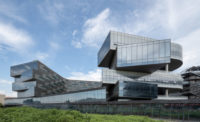| Photo © Lara Swimmer |
With the recent arrival of their second child, architect Robert Zimmer and his wife, photographer Lara Swimmer, have grown accustomed to planning for the not-quite-knowable. While thinking about their own 4,250-square-foot live/work building in the North Admiral district of Seattle, they got to practice these skills — imagining not just how it would evolve as the kids grew up, but how it might accommodate new zoning in a changing neighborhood. Although the area right now is zoned for multifamily use on two sides and commercial on another, it is becoming more densely developed. So Zimmer designed the building to be adaptable, creating a wing on one side that he uses as his office but could be converted into an accessory dwelling unit or a commercial space. He and his family currently live in the two upper floors, but a new owner might divide it into multiple apartments or office space for multiple tenants. He even designed stacked storage rooms on all three floors so an elevator could be installed there in the future. Flexibility informs the project now as well, with a conference room on the second floor becoming a home theater in the evening.
To stay within a tight budget ($870,000), Zimmer and his firm, Zimmerraystudios, designed an efficient structure that uses structural insulated panels (SIPs), engineered lumber, and some steel, and created interiors with “luxury in spaces, not finishes,” he says. Exposed structural elements, along with simple materials such as plate steel, oriented strand board, and colored polycarbonate panels, establish an aesthetic that is “rough-and-tumble but elegant at the same time,” says the architect. “I tried to pare it down as much as possible to create open, flexible space for as little money as possible.” At $205 a square foot, he hit his mark. “It was a fantastic experience designing the project,” he says, “but a horrible experience building it,” due to problems with the contractor, whom he eventually fired. If he had a client, he would have fired the contractor earlier on, admits Zimmer.
Zimmer hates the term “green” because he says all good design takes environmental issues into consideration. But the great majority of the building’s materials and products come from local sources, most within five miles. He also designed the building so solar panels can be installed and rainwater collected. Designing for himself and his family was easy, states Zimmer. What was hard was “taking the financial leap.”








Post a comment to this article
Report Abusive Comment